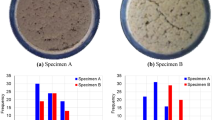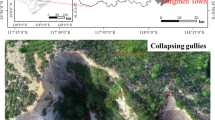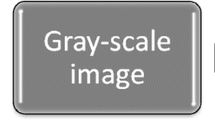Abstract
The characterization of a soil crack network requires a comprehensive understanding of statistics and has been of longstanding interest but not well resolved. By performing a series of desiccation cracking tests with a soil mixture comprising fines and montmorillonite, we make a systematic examination of the effect of the container shape on the anisotropic distribution of a crack network. The statistical analyses show that the angular distributions of crack orientation and length vectors in the cases of square and rectangular shapes have the feature of orthogonal concentration in two angular zones near the horizontal and vertical directions (i.e., − 15° < ϕ < 15° and 75° < ϕ < 105°) and that a larger magnitude of anisotropy results in a more intense concentration around the principal direction of anisotropy, whereas the angular distributions of these two vectors are in an almost isotropic state for the circular shape. The angular distributions of crack width and area vectors do not have an orthogonal concentration for any container shape. The distributions of crack area vectors approximate to an isotropic state for the square and circular shapes and have weak anisotropy for the rectangular shapes, with the principal direction of anisotropy being near the vertical direction. It is revealed that either the crack length or width vector exercises a dominant influence on the angular distribution anisotropy of crack area vectors only if its angular distribution bears relatively strong anisotropy.
















Similar content being viewed by others
References
Akiba Y, Shima H (2019) Flow-velocity-dependent transition of anisotropic crack patterns in CaCO3 paste. J Phys Soc Jpn 88:024001
Alava MJ, Nukala PKVV, Zapperi S (2006) Morphology of two dimensional fracture surfaces. J Stat Mech 10:L10002
An N, Tang C, Cheng Q, Wang D, Shi B (2020) Application of electrical resistivity method in the characterization of 2D desiccation cracking process of clayey soil. Eng Geol 265:105416
Arena A, Delle Piane C, Sarout J (2014) A new computational approach to cracks quantification from 2D image analysis: application to micro-cracks description in rocks. Comput Geosci 66:106–120
Bai T, Pollard DD, Gao H (2000) Explanation for fracture spacing in layered materials. Nature 403:753–756
Baker R (1981) Tensile strength, tension cracks, and stability of slopes. Soils Found 21:1–17
Basson MS, Ayothiraman R (2020) Effect of human hair fiber reinforcement on shrinkage cracking potential of expansive clay. Bull Eng Geol Environ 79:2159–2168
Boehm-Courjault E, Barbotin S, Leemann A, Scrivener K (2020) Microstructure, crystallinity and composition of alkali-silica reaction products in concrete determined by transmission electron microscopy. Cem Concr Res 130:105988
Bohn S, Pauchard L, Couder Y (2005a) Hierarchical crack pattern as formed by successive domain divisions. I. Temporal and geometrical hierarchy. Phys Rev E 71:046214
Bohn S, Platkiewicz J, Andreotti B, Adda-Bedia M, Couder Y (2005b) Hierarchical crack pattern as formed by successive domain divisions. II. From disordered to deterministic behavior. Phys Rev E 71:046215
Bulolo S, Leong EC, Kizza R (2021) Tensile strength of unsaturated coarse and fine-grained soils. Bull Eng Geol Environ 80:2727–2750
Cheng Q, Tang CS, Zhu C, Li K, Shi B (2020) Drying-induced soil shrinkage and desiccation cracking monitoring with distributed optical fiber sensing technique. Bull Eng Geol Environ 79:3959–3970
Cortet P, Huillard G, Vanel L, Ciliberto S (2008) Attractive and repulsive cracks in a heterogeneous. J Stat Mech 10:P10022
Costa S, Kodikara J, Shannon B (2013) Salient factors controlling desiccation cracking of clay in laboratory experiments. Géotechnique 63:18–29
Dai BB, Yang J (2017) Shear strength of assemblies of frictionless particles. International Journal of Geomechanics ASCE 17:04017102
Dai BB, Yang J, Luo XD (2015) A numerical analysis of the shear behavior of granular soil with fines. Particuology 21:160–172
Dai BB, Yang J, Zhou CY (2017) Micromechanical origin of angle of repose in granular materials. Granul Matter 19:24
Dai BB, Yang J, Zhou CY, Luo XD (2016) DEM investigation on the effect of sample preparation on the shear behavior of granular soil. Particuology 25:111–121
DeCarlo KF, Shokri N (2014) Effects of substrate on cracking patterns and dynamics in desiccating clay layers. Water Resour Res 50:3039–3051
Fernandes M, Denis A, Fabre R, Lataste JF, Chrétien M (2015) In situ study of the shrinkage-swelling of a clay soil over several cycles of drought-rewetting. Eng Geol 192:63–75
Goehring L (2013) Evolving fracture patterns: columnar joints, mud cracks and polygonal terrain. Phil Trans R Soc A 371:20120353
Goehring L, Conroy R, Akhter A (2010) Evolution of mud-crack patterns during repeated drying cycles. Soft Matter 6:3562–3567
Gui Y, Zhao GF (2015) Modelling of laboratory soil desiccation cracking using DLSM with a two-phase bond model. Comput Geotech 69:578–587
Hawkins AB (2013) Some engineering geological effects of drought: examples from the UK. Bull Eng Geol Environ 72:37–59
Hu T, Guilleminot J, Dolbow JE (2020) A phase-field model of fracture with frictionless contact and random fracture properties: application to thin-film fracture and soil desiccation. Comput Methods Appl Mech Engrg 368:113106
Julina M, Thyagaraj T (2020) Combined effects of wet-dry cycles and interacting fluid on desiccation cracks and hydraulic conductivity of compacted clay. Eng Geol 267:105505
Kanatani K (1984) Distribution of directional data and fabric tensors. Int J Engng Sci 22:149–164
Khan MS, Hossain S, Ahmed A, Faysal M (2017) Investigation of a shallow slope failure on expansive clay in Texas. Eng Geol 219:118–129
Khatun T, Dutta T, Tarafdar S (2013) Crack formation under an electric field in droplets of laponite gel: memory effect and scaling relations. Langmuir 29:15535–15542
Khatun T, Dutta T, Tarafdar S (2015) Topology of desiccation crack patterns in clay and invariance of crack interface area with thickness. Eur Phys J E 38:83
Kindle EM (1917) Some factor affecting the development of mud-cracks. J Geol 25:135–144
Kitsunezaki S, Nakahara A, Matsuo Y (2016) Shaking-induced stress anisotropy in the memory effect of paste. EPL 114:64002
Kitsunezaki S, Sasaki A, Nishimoto A, Mizuguchi T, Matsuo Y, Nakahara A (2017) Memory effect and anisotropy of particle arrangements in granular paste. Eur Phys J E 40:88
Kokkoniemi R, Ovaska M, Laurson L, Alava MJ (2017) Intermittent crack growth in fatigue. J Stat Mech 07:073401
Krisdani H, Rahardjo H, Leong EC (2008) Effects of different drying rates on shrinkage characteristics of a residual soil and soil mixtures. Eng Geol 102:31–37
Lakshmikantha MR, Prat PC, Ledesma A (2018) Boundary effects in the desiccation of soil layers with controlled environmental conditions. Geotech Test J 41:675–697
Li JH, Zhang LM (2011) Study of desiccation crack initiation and development at ground surface. Eng Geol 123:347–358
Liu C, Tang CS, Shi B, Suo WB (2013) Automatic quantification of crack patterns by image processing. Comput Geosci 57:77–80
Liu T, Luo H, Ma J, Xie W, Wang Y, Jing G (2016) Surface roughness induced cracks of the deposition film from drying colloidal suspension. Eur Phys J E 39:24
Lu Y, Liu S, Weng L, Wang L, Li Z, Xu L (2016) Fractal analysis of cracking in a clayey soil under freeze-thaw cycles. Eng Geol 208:93–99
Matsuo Y, Nakahara A (2012) Effect of interaction on the formation of memories in paste. J Phys Soc Jpn 81:024801
Miller CJ, Mi H, Yesiller N (1998) Experimental analysis of desiccation cracking propagation in clay, liners. J Am Water Resour Assoc 34:677–686
Modes CD, Magnasco MO, Katifori E (2016) Extracting hidden hierarchies in 3D histribution networks Phys Rev X 6:031009
Nakahara A, Matsuo Y (2006a) Imprinting memory into paste to control crack formation in drying process. J Stat Mech 07:P07016
Nakahara A, Matsuo Y (2006b) Transition in the pattern of cracks resulting from memory effects in paste. Phys Rev E 74:045102
Nakayama H, Matsuo Y, Takeshi O, Nakahara A (2013) Position control of desiccation cracks by memory effect and Faraday wave. Eur Phys J E 36:1
Nakahara A, Hiraoka T, Hayashi R, Matsuo Y, Kitsunezaki S (2019) Mechanism of memory effect of paste which dominates desiccation crack patterns. Phil Trans R Soc A 377:20170395
Nishiuma S, Miyazima S (1999) Crack growth and percolation in anisotropically rolled thin plate. Physica A 266:209–213
Oda M (1999) Introduction to mechanics of granular materials ed M Oda and K Iwashita (Publisher: A.A. Balkema Rotterdam Netherlands) 27–35
Omidi GH, Thomas JC, Brown KW (1996) Effect of desiccation cracking on the hydraulic conductivity of a compacted clay liner. Water Air Soil Pollut 89:91–103
Peng X, Zhang Z, Gan L, Yoshida S (2016) Linking soil shrinkage behavior and cracking in two paddy soils as affected by wetting and drying cycles. Soil Sci Soc Am J 80:1145–1156
Péron H, Hueckel T, Laloui L, Hu L (2009) Fundamentals of desiccation cracking of fine- grained soils: experimental characterisation and mechanisms identification. Can Geotech J 46:1177–1201
Rodríguez R, Sánchez M, Ledesma A, Lloret A (2007) Experimental and numerical analysis of desiccation of a mining waste. Can Geotech J 44:644–658
Rothenburg L, Bathurst RJ (1989) Analytical study of induced anisotropy in idealized granular materials. Géotechnique 39(1989):601–614
Sánchez M, Manzoli OL, Guimarães LJN (2014) Modeling 3-D desiccation soil crack networks using a mesh fragmentation technique. Comput Geotech 62:27–39
Satake M (1982) Fabric tensor in granular materials IUTAM Symp. on Deformation and Failure of Granular Materials Delft. 63–68
Stirling RA (2014) Multiphase modelling of desiccation cracking in compacted cracking in compacted soil. PhD thesis Newcastle University
Sun WJ, Cui YJ (2017) Investigating the microstructure changes for silty soil during drying. Géotechnique 68:1–4
Tang C, Shi B, Liu C, Zhao L, Wang B (2008) Influencing factors of geometrical structure of surface shrinkage cracks in clayey soils. Eng Geol 101:204–217
Tang C, Shi B, Liu C, Suo WB, Gao L (2011) Experimental characterization of shrinkage and desiccation cracking in thin clay layer. Appl Clay Sci 52:69–77
Tang C, Wang D, Zhu C, Zhou QY, Xu SK, Shi B (2018) Characterizing drying induced clayey soil desiccation cracking process using electrical resistivity method. Appl Clay Sci 152:101–112
Tang C, Zhu C, Leng T, Shi B, Cheng Q, Zeng H (2019) Three-dimensional characterization of desiccation cracking behavior of compacted clayey soil using X-ray computed tomography. Eng Geol 255:1–10
Tay YY, Stewart DI, Cousens TW (2001) Shrinkage and desiccation cracking in bentonite–sand landfill liners. Eng Geol 60:263–274
Tollenaar RN, van Paassen LA, Jommi C (2017) Observations on the desiccation and cracking of clay layers. Eng Geol 230:23–31
Vo TD, Pouya A, Hemmati S, Tang AM (2019) Modelling desiccation crack geometry evolution in clayey soils by analytical and numerical approaches. Can Geotech J 56:720–729
Wang C, Zhang Z, Liu Y, Fan S (2017) Geometric and fractal analysis of dynamic cracking patterns subjected to wetting-drying cycles. Soil till Res 170:1–13
Wang LL, Tang CS, Shi B, Cui YJ, Zhang GQ, Hilary I (2018) Nucleation and propagation mechanisms of soil desiccation cracks. Eng Geol 238:27–35
Weinberger R (1999) Initiation and growth of cracks during desiccation of stratified muddy soils. J Struct Geol 21:379–386
Yang J, Dai BB (2011) Is the quasi-steady state a real behaviour? A micromechanical perspective. Géotechnique 61:175–184
Yuan S, Yang B, Liu J, Cao B (2021) Influence of fibers on desiccation cracks in sodic soil. Bull Eng Geol Environ 80:3207–3216
Zeng H, Tang C, Cheng Q, Inyang HI, Rong DZ, Lin L, Shi B (2019) Coupling effects of interfacial friction and layer thickness on soil desiccation cracking behavior. Eng Geol 260:105220
Zhang Y, Ye WM, Chen B, Chen YG, Ye B (2016) Desiccation of NaCl-contaminated soil of earthen heritages in the Site of Yar City, northwest China. Appl Clay Sci 124–125:1–10
Zhang Z, Zhu W, Zhu C, Wang C, Wu C, Si H (2013) Statistical characteristics of random distribution of shrinkage cracks on farmland soil surface. Trans Chin Soc Agric Eng 29:119–124
Zhao YP, Chen J, Yuan Q, Cheng C (2016) Microcrack connectivity in rocks: a real-space renormalization group approach for 3D anisotropic bond percolation. J Stat Mech 01:013205
Acknowledgements
The authors appreciate financial support provided by the National Natural Science Foundation of China (No. 52078507), the Science and Technology Program of Guangzhou City under grant No. 202002030195, the Science and Technology Program of Zhuhai City under grant No. ZH22036204200009PWC, and the Natural Science Foundation of Guangdong Province under grant No. (2018A030313897). Support from HKRGC under the General Research Fund scheme (Grant No. 17250316) is also acknowledged. The authors extend their sincere gratitude to Mr. Chang-Wen Xu and Mr. Yi-Yuan Chen for their kind assistance in the experimental work.
Author information
Authors and Affiliations
Corresponding author
Rights and permissions
About this article
Cite this article
Dai, BB., Yang, J., Liu, FT. et al. Morphological description of desiccation cracks in soils: insights from the perspective of anisotropy. Bull Eng Geol Environ 81, 94 (2022). https://doi.org/10.1007/s10064-022-02600-7
Received:
Accepted:
Published:
DOI: https://doi.org/10.1007/s10064-022-02600-7




